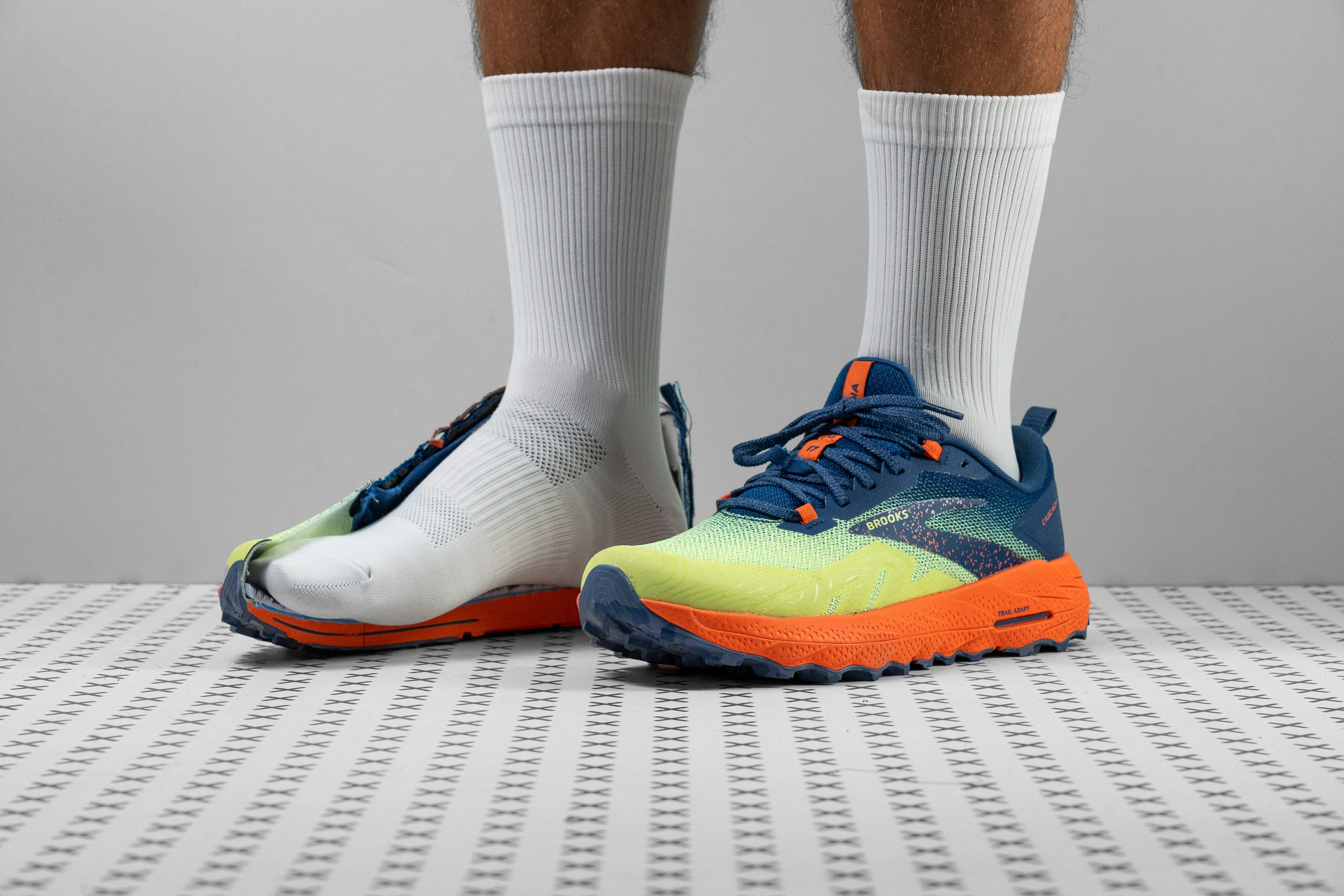Our verdict
- Top pick in best Brooks trail running shoes (2023)
Pros
- Adaptable across various paces
- World-class breathability
- Comfortable for long runs
- Superior grip thanks to TrailTack Green
- Environmentally-friendly with recycled materials
- Excellent stability
- Rock plate protects the foot
- Manages technical descents with ease
- Ideally designed for heel strikers
Cons
- Weighs more than v16
- Midsole may feel overly firm for certain users
Audience verdict
Comparison
The most similar running shoes compared
+ + Add a shoe | |||||
|---|---|---|---|---|---|
| Audience score | 86 Good! | 86 Good! | 83 Good! | 86 Good! | |
| Price | $140 | $150 | $155 | $100 | |
| Trail terrain | ModerateTechnical | LightModerate | Moderate | Light | |
| Shock absorption | - | Moderate | - | - | |
| Energy return | - | Moderate | - | - | |
| Traction | - | High | - | - | |
| Arch support | Neutral | Neutral | Neutral | Neutral | |
| Weight lab Weight brand | 11.6 oz / 329g 11 oz / 312g | 10.8 oz / 306g 10.7 oz / 303g | 9.6 oz / 271g 9.5 oz / 270g | 9.9 oz / 282g 10.4 oz / 294.8g | |
| Drop lab Drop brand | 9.2 mm 8.0 mm | 7.8 mm 6.0 mm | 8.9 mm 6.0 mm | 9.2 mm 8.0 mm | |
| Strike pattern | HeelMid/forefoot | Mid/forefoot | HeelMid/forefoot | HeelMid/forefoot | |
| Size | True to size | True to size | Half size small | True to size | |
| Midsole softness | Balanced | Balanced | Soft | Balanced | |
| Difference in midsole softness in cold | Normal | Normal | Normal | Big | |
| Plate | Rock plate | Rock plate | ✗ | ✗ | |
| Toebox durability | Bad | Good | Very bad | Bad | |
| Heel padding durability | Bad | Decent | Bad | Bad | |
| Outsole durability | Good | Good | Decent | Decent | |
| Breathability | Breathable | Moderate | Moderate | Moderate | |
| Width / fit | Medium | Medium | Medium | Medium | |
| Toebox width | Wide | Medium | Medium | Wide | |
| Stiffness | Stiff | Moderate | Stiff | Stiff | |
| Torsional rigidity | Stiff | Stiff | Stiff | Moderate | |
| Heel counter stiffness | Stiff | Stiff | Stiff | Stiff | |
| Lug depth | 3.9 mm | 3.8 mm | 3.4 mm | 2.7 mm | |
| Heel stack lab Heel stack brand | 33.1 mm | 34.8 mm 35.0 mm | 29.3 mm 34.0 mm | 32.1 mm 30.0 mm | |
| Forefoot lab Forefoot brand | 23.9 mm | 27.0 mm 29.0 mm | 20.4 mm 28.0 mm | 22.9 mm 22.0 mm | |
| Widths available | NormalWide | NormalWide | Normal | Normal | |
| For heavy runners | ✗ | ✓ | ✗ | ✗ | |
| Season | SummerAll seasons | All seasons | All seasons | All seasons | |
| Removable insole | ✓ | ✓ | ✓ | ✓ | |
| Orthotic friendly | ✓ | ✓ | ✓ | ✓ | |
| Ranking | #365 Bottom 45% | #191 Bottom 49% | #266 Bottom 29% | #182 Top 49% | |
| Popularity | #356 Bottom 46% | #111 Top 30% | #199 Bottom 46% | #261 Bottom 30% |
Who should buy
The latest version of this trail workhorse from Brooks is ideal for:
- Those looking for a versatile shoe that can tackle all types of trails.
- Heel strikers seeking a protective and stable trail option.
- Runners who prioritize maximum breathability, a feature that's hard to come by in trail shoes.

Who should NOT buy
For those of you seeking feather-light trail shoes, the Cascadia 17 might not be the go-to pick. Its predecessor already tipped the scales, and this year's model packs extra weight. We recommend the cushioned Hoka Speedgoat 5 for a lighter alternative.
Another runner profile less likely to favor this Brooks model includes those after a cloud-like underfoot feel. The DNA Loft v2 foam borders on firmness and lacks that cloud sensation. If you're part of this group, we vouch for the ultra-plush Nike Wildhorse 8 as a better choice.
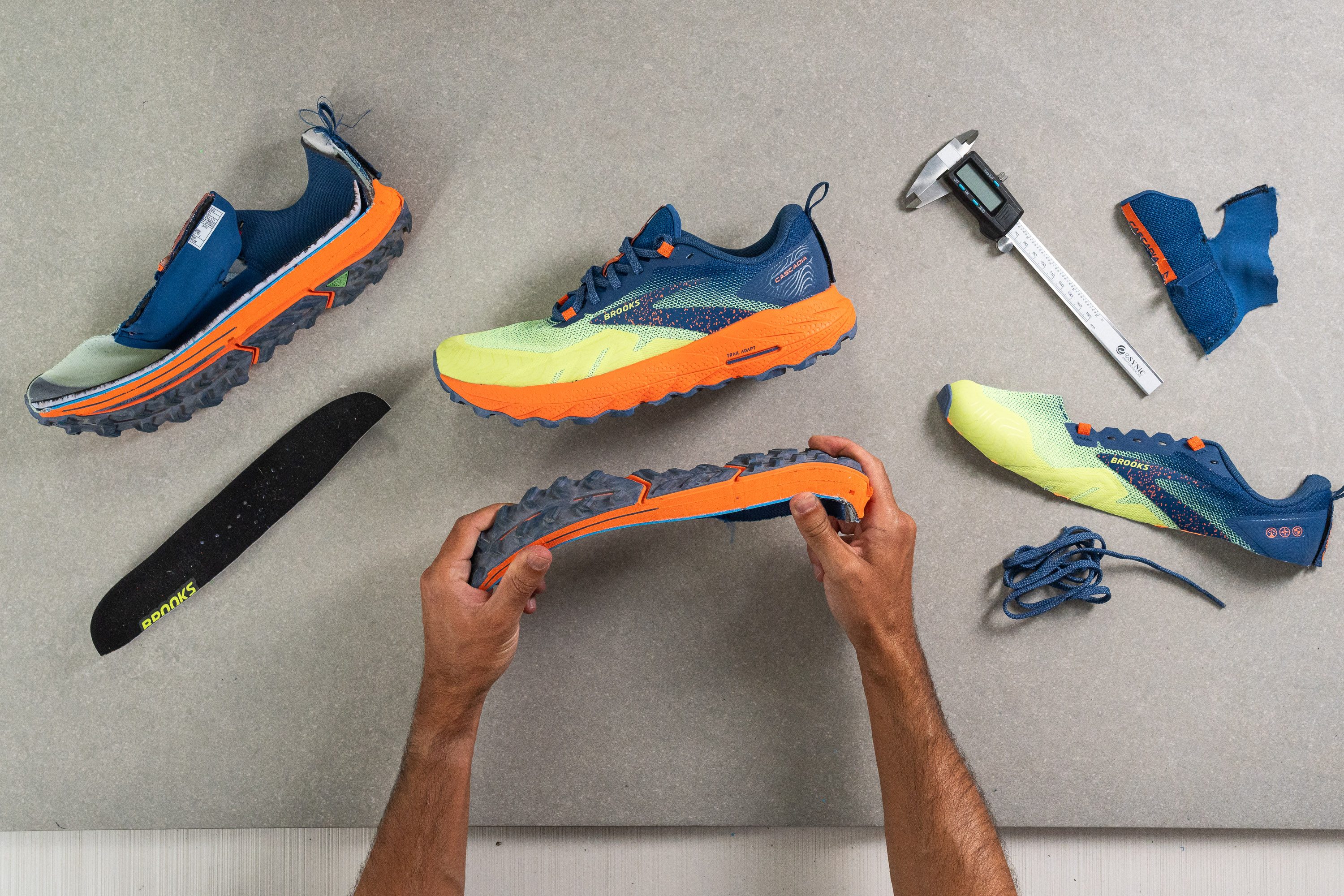
Finally, if you're looking for a hybrid trail/road experience, this option isn't the top pick in the market. Consider the Salomon Sense Ride 5 for a more versatile choice.
Cushioning
Heel stack
Brooks has wisely chosen to provide ample foam, ensuring the comfort of all heel strikers, even those on the heavier side.
Our caliper showed a thickness of 33.1 mm.
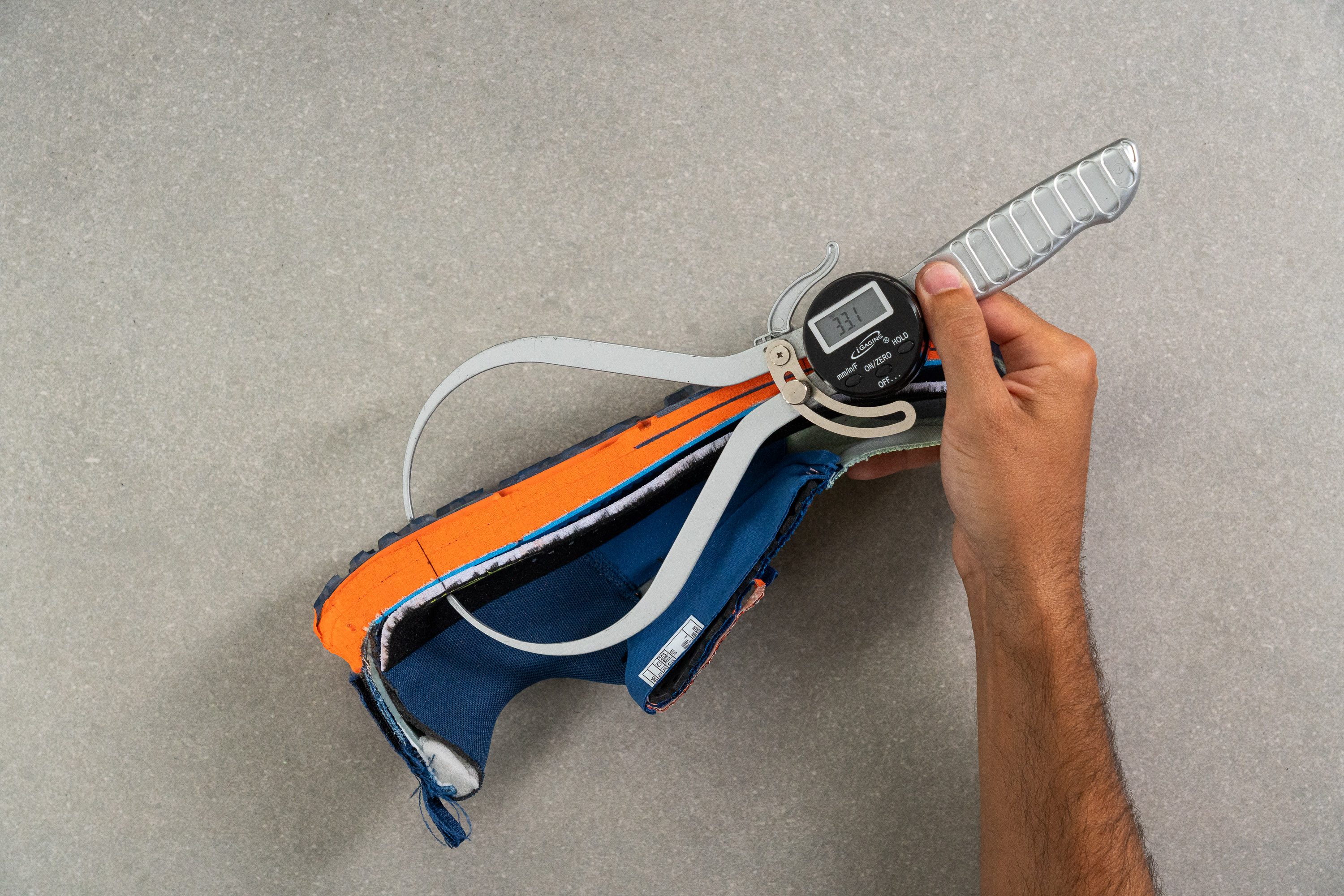
| Cascadia 17 | 33.1 mm |
| Average | 32.6 mm |
Forefoot stack
In the forefoot area, the cushioning suits both midfoot and forefoot strikers at 23.9 mm.
However, heavier forefoot strikers might lean towards shoes with some additional millimeters, like the New Balance Fresh Foam X More Trail v3.
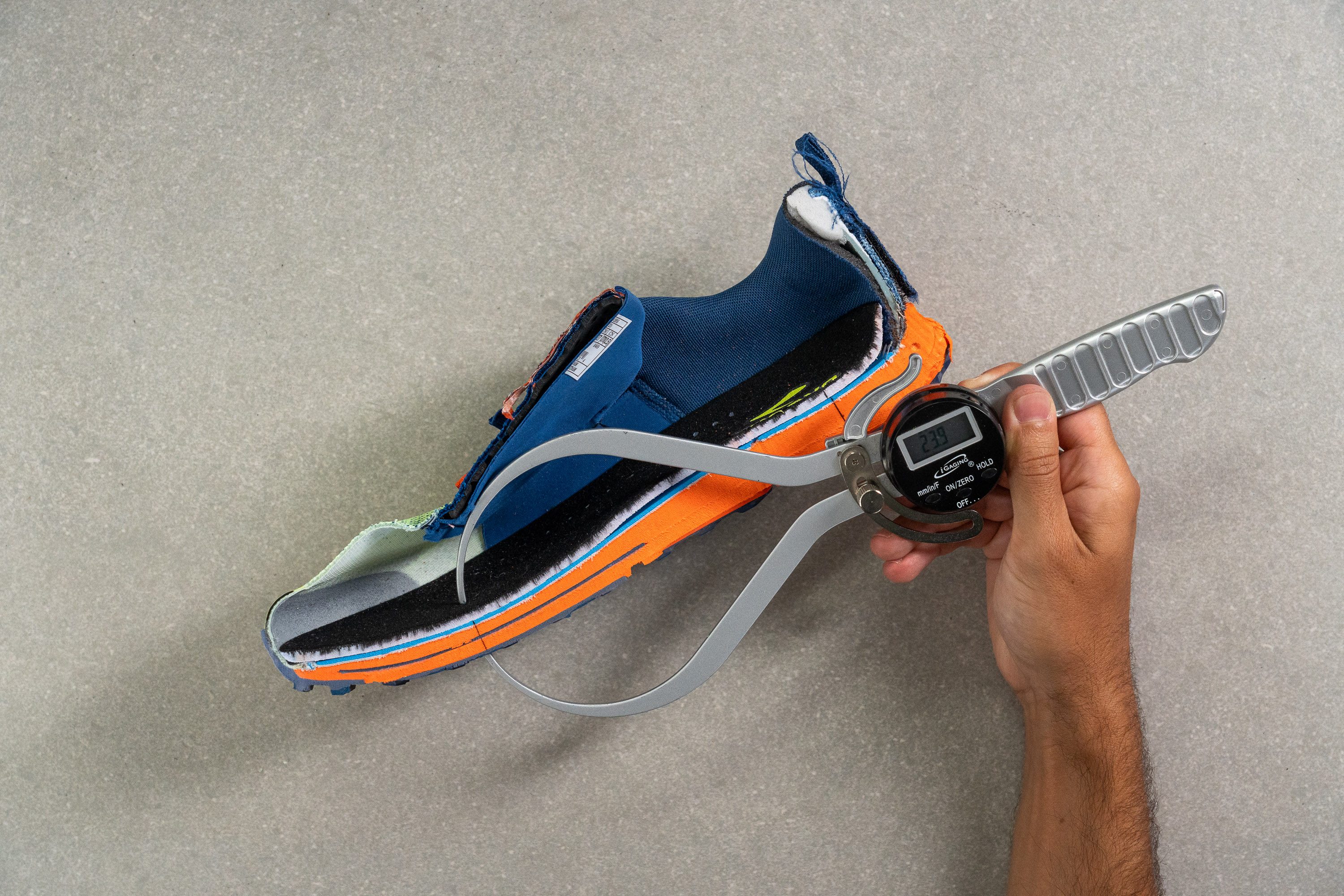
| Cascadia 17 | 23.9 mm |
| Average | 25.1 mm |
Drop
Reaffirming its suitability for heel strikers, the Cascadia 17 offers a 9.2-mm heel-to-toe drop. This is slightly more than the 8 mm the American brand claims.
To understand the reason behind this discrepancy, we recommend reading our related guide.
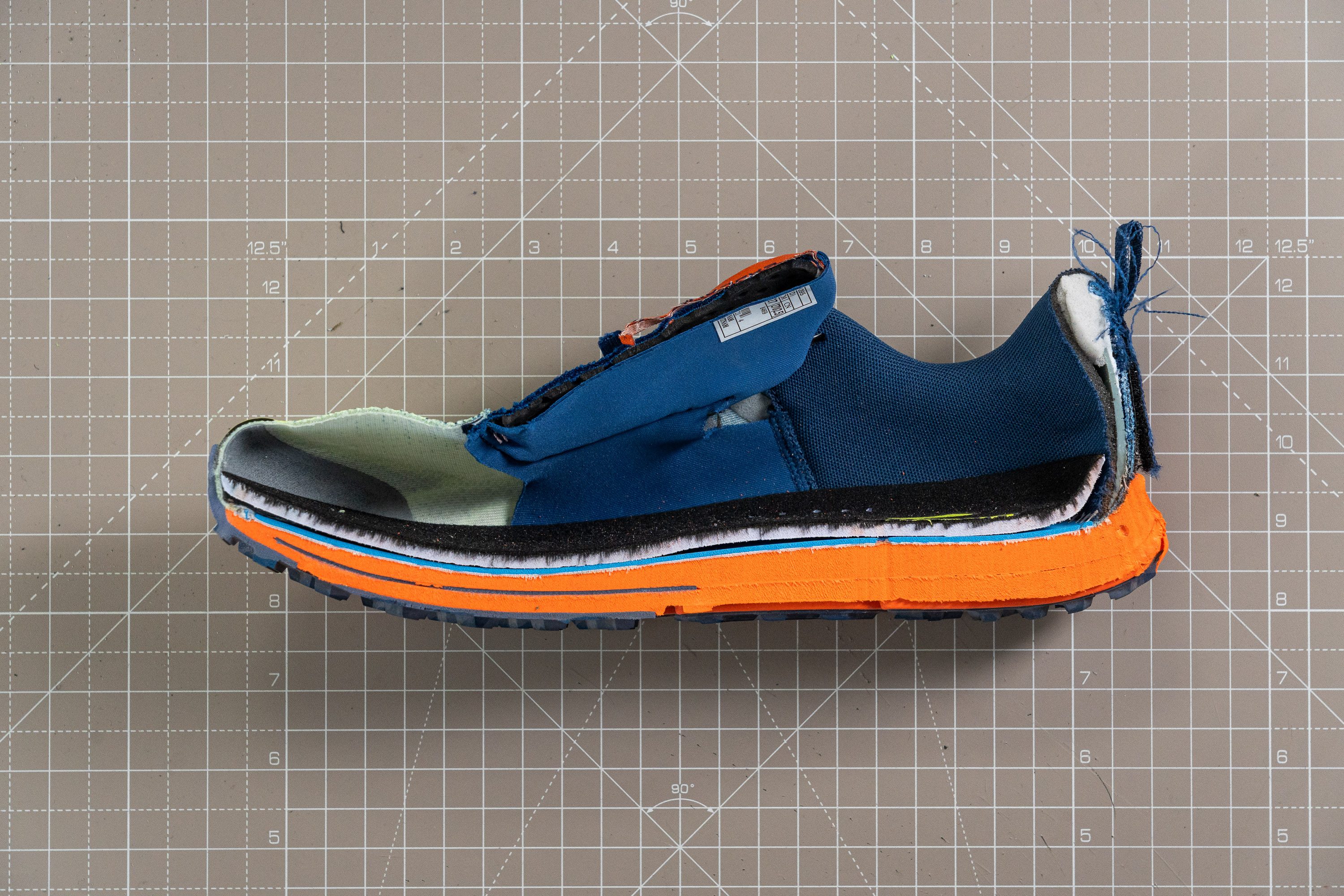
| Cascadia 17 | 9.2 mm |
| Average | 7.5 mm |
Midsole softness
In the midsole, we found Brooks' trusted DNA Loft v2 foam, which is also featured in their popular road shoes, such as the Adrenaline GTS 23.
This foam offers a the same nice bounce but is modified to be firmer (25.5 HA) than its road counterpart. It's a strategic decision for trail running where stability is crucial, even if it means giving up a bit of softness.
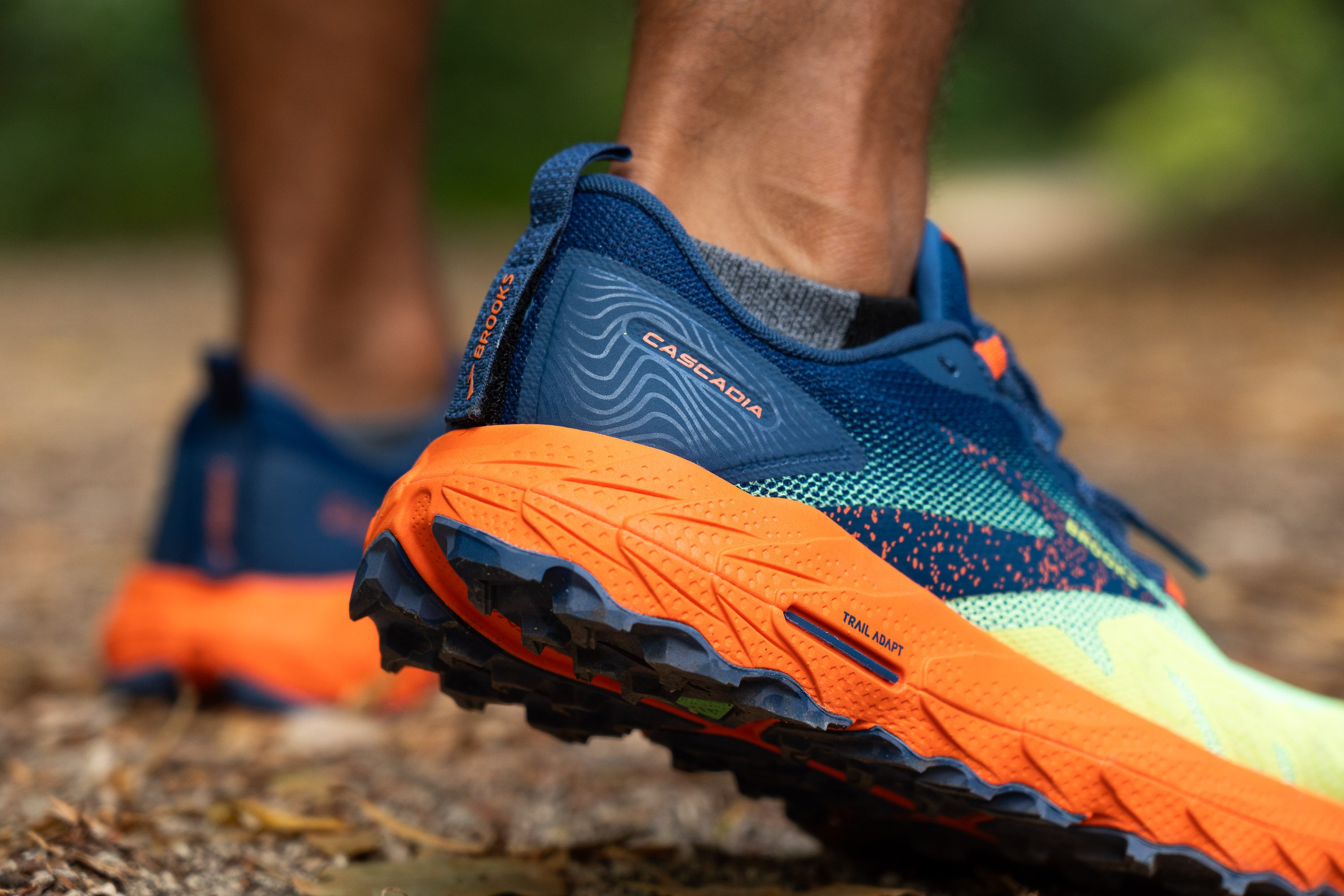
Additionally, the shoe incorporates a rock plate in the forefoot area, adding protection against rough terrains, as well as the Trail Adapt system sandwiched between two layers of foam.
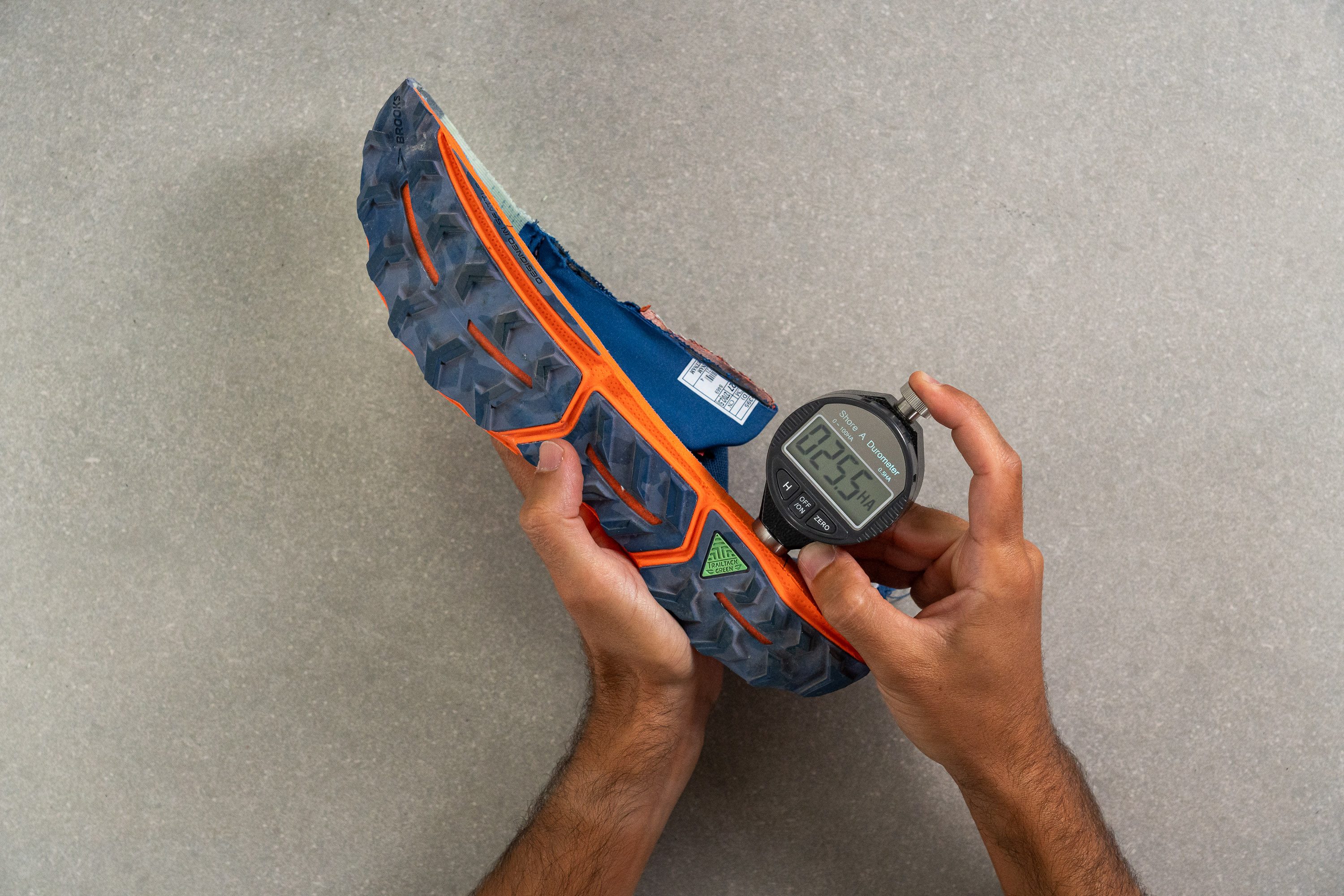
| Cascadia 17 | 25.5 HA |
| Average | 21.9 HA |
Size and fit
Size
Brooks Cascadia 17 fits true to size (116 votes).
Width / Fit
The toebox of the Cascadia 17 measures 99.5 mm at its widest point. This generous size ensures that those with wider feet can comfortably fit inside the shoe.

This test follows an older methodology, which is why you don't see recently tested shoes in the chart. Results from different methodologies can not be compared.
| Cascadia 17 | 99.5 mm |
| Average | 98.9 mm |
Toebox width
We found an impressive 80.3 mm in the toe cap area, which is remarkably more than the typical shoe.

This test follows an older methodology, which is why you don't see recently tested shoes in the chart. Results from different methodologies can not be compared.
| Cascadia 17 | 80.3 mm |
| Average | 79.3 mm |
Traction / Grip
Lug depth
We measured the lug depth of the Cascadia 17 at 3.9mm. This depth strikes a good balance, making the shoe apt for both simple and technical terrains. They're 0.4mm less deep than the previous version, and we feel it's the right direction for such a shoe.
It's also worth mentioning that Brooks incorporates three distinct lug designs in the Cascadia 17:
- The heel features penetration lugs for optimal grip.
- The midfoot lugs are plain, reducing mud clumping and ensuring better traction.
- The forefoot boasts wedge-like lugs, enhancing agility during turns.
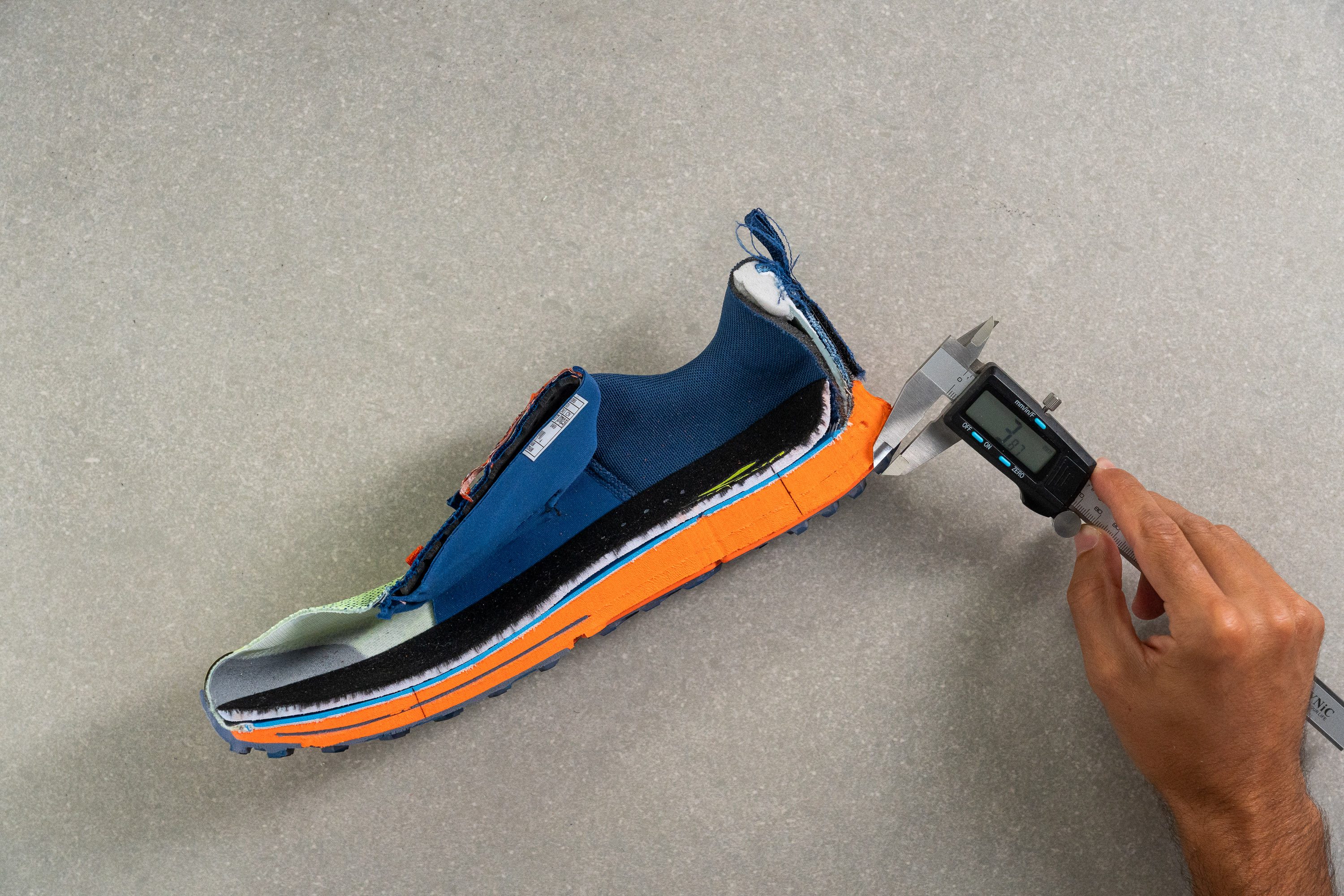
| Cascadia 17 | 3.9 mm |
| Average | 3.5 mm |
Flexibility / Stiffness
A common criticism from runners regarding the previous Cascadia was its excessive stiffness.
| Shoe | Stiffness test (N) | Difference |
| Brooks Cascadia 17 | 26.0 | - |
| Brooks Cascadia 16 | 51.5 | 98% |
Yes, we wrote that right. The Cascadia 16 was 98% stiffer than this new version, even though it already felt moderately stiff. This change is a step in the right direction. The shoe is designed for long-distance runs and even ultras, emphasizing comfort.
Before, it was just too rigid to excel in this area. Now, it achieves a much better balance as proved by our 90-degree bend test.
This test follows an older methodology, which is why you don't see recently tested shoes in the chart. Results from different methodologies can not be compared.
| Cascadia 17 | 26.0N |
| Average | 27.1N |
Stiffness in cold (%)
We tested the shoe in the freezer again to see how it responds to cold temperatures.
It does become stiffer, but not dramatically so. In fact, with a measurement of 37.9N, it remains comfortably below the average.
The variation between the two readings is 46.1%. This significant change makes it clear that you'll notice the difference for sure.
| Cascadia 17 | 46% |
| Average | 32% |
Weight
Weighing in at 11.6 oz (329g), the Cascadia 17 is slightly heavier than the Cascadia 16. It's a small increase—just 0.6 oz (19g) more than its predecessor—so we don't think it will make a significant difference in the trails.
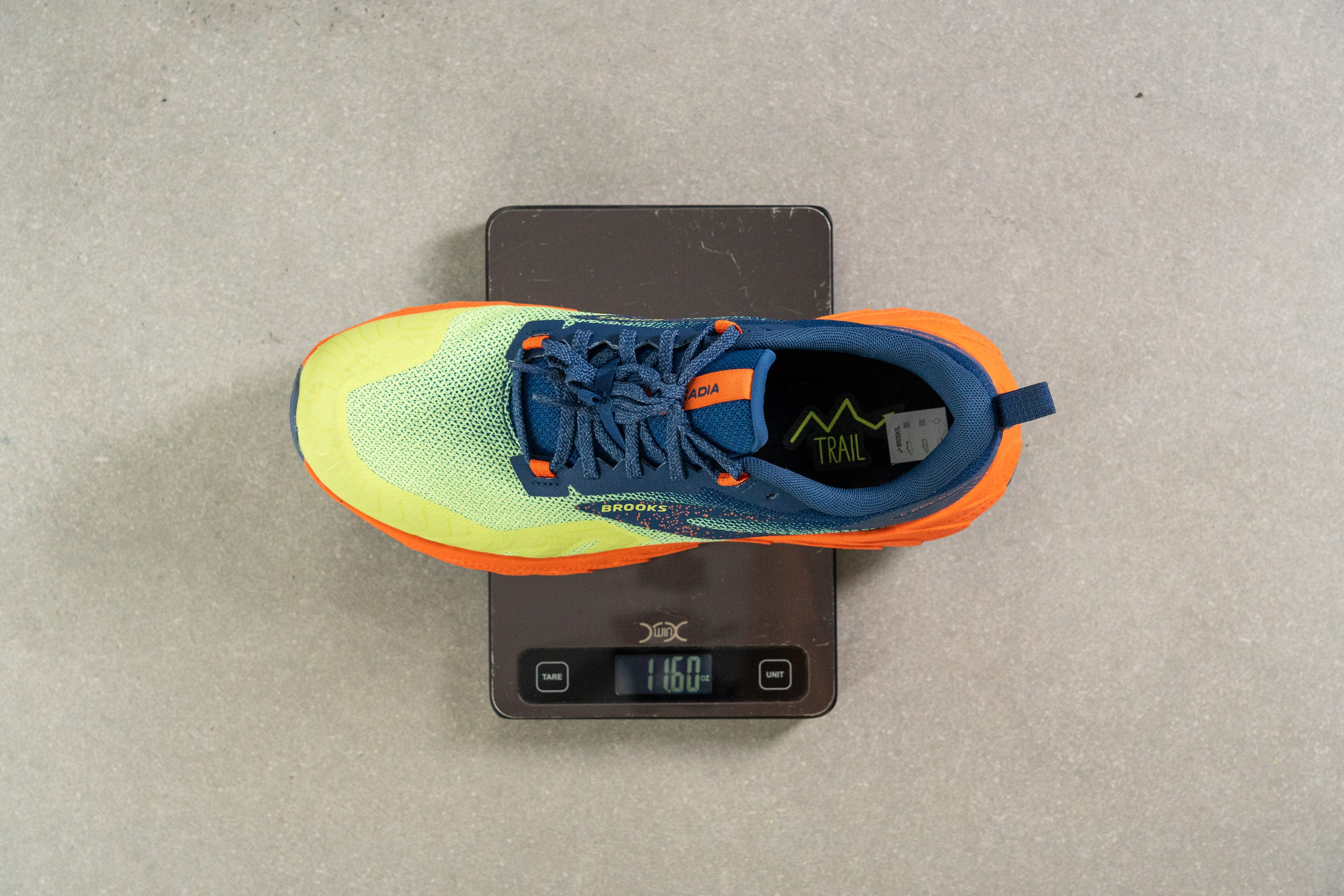
| Cascadia 17 | 11.6 oz (329g) |
| Average | 10.2 oz (289g) |
Breathability
Many trail running shoes typically offer just adequate breathability, so in our lab, our expectations are generally reserved with these. Yet, the 17th edition of the Cascadia pleasantly surprised us. After our assessments, we gave it the max score: 5 out of 5.
A good portion of the shoe's breathability originates from its toe box. The rest of the shoe maintains a more protective stance, which is often necessary for trail shoes to ensure additional structure, especially on the medial side and the heel.
To better understand this shoe's airflow capabilities, we took a closer look under our microscope.

What we observed was interesting. The Cascadia manages its effective breathability through a well-designed mesh, filled with numerous small ventilation holes, negating the need for larger ones.
Additionally, Brooks has crafted this mesh to be not just breathable but also durable, incorporating internal layers for both protection and comfort. And more than 50% of the upper is made with recycled materials, which is a plus.
| Cascadia 17 | 5 |
| Average | 3.2 |
Stability
Lateral stability test
One of the standout benefits of embracing a firmer foam is the remarkable enhancement in stability.
The Cascadia 17 guarantees a consistently stable ride on every type of terrain.
Torsional rigidity
A significant contributor to the Cascadia's stability is its inherent stiffness. In our torsional rigidity test, we awarded it a 4/5—nearly the max score.
| Cascadia 17 | 4 |
| Average | 3.6 |
Heel counter stiffness
For the heel counter, the Cascadia 17 scored a 5/5. Rigid-heel enthusiasts or those with stability issues will surely appreciate this design. However, those seeking a more heel-flexible design dislike this feature.
| Cascadia 17 | 5 |
| Average | 3 |
Midsole width - forefoot
A crucial aspect of crafting a stable shoe is its wide design, and the Cascadia ticks this box.
Measuring at 113.3 mm, none of us—even forefoot strikers—have any worries about shaky landings.
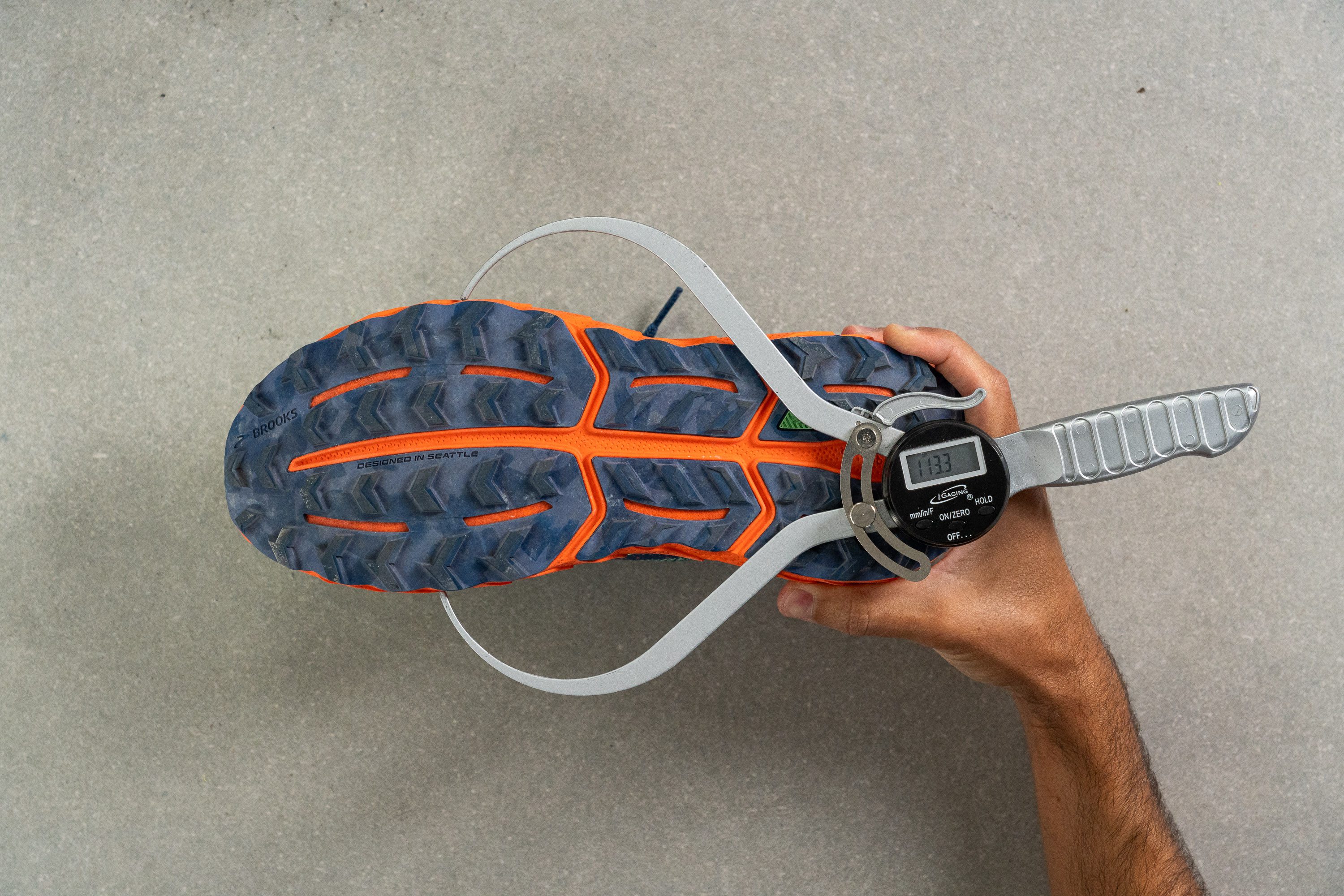
| Cascadia 17 | 113.3 mm |
| Average | 112.8 mm |
Midsole width - heel
With an impressive 97.7 mm width, the Cascadia 17 distinguishes itself from the common trail shoe crowd, confirming our perspective that heel strikers will find it amazing. It's wiiiide!
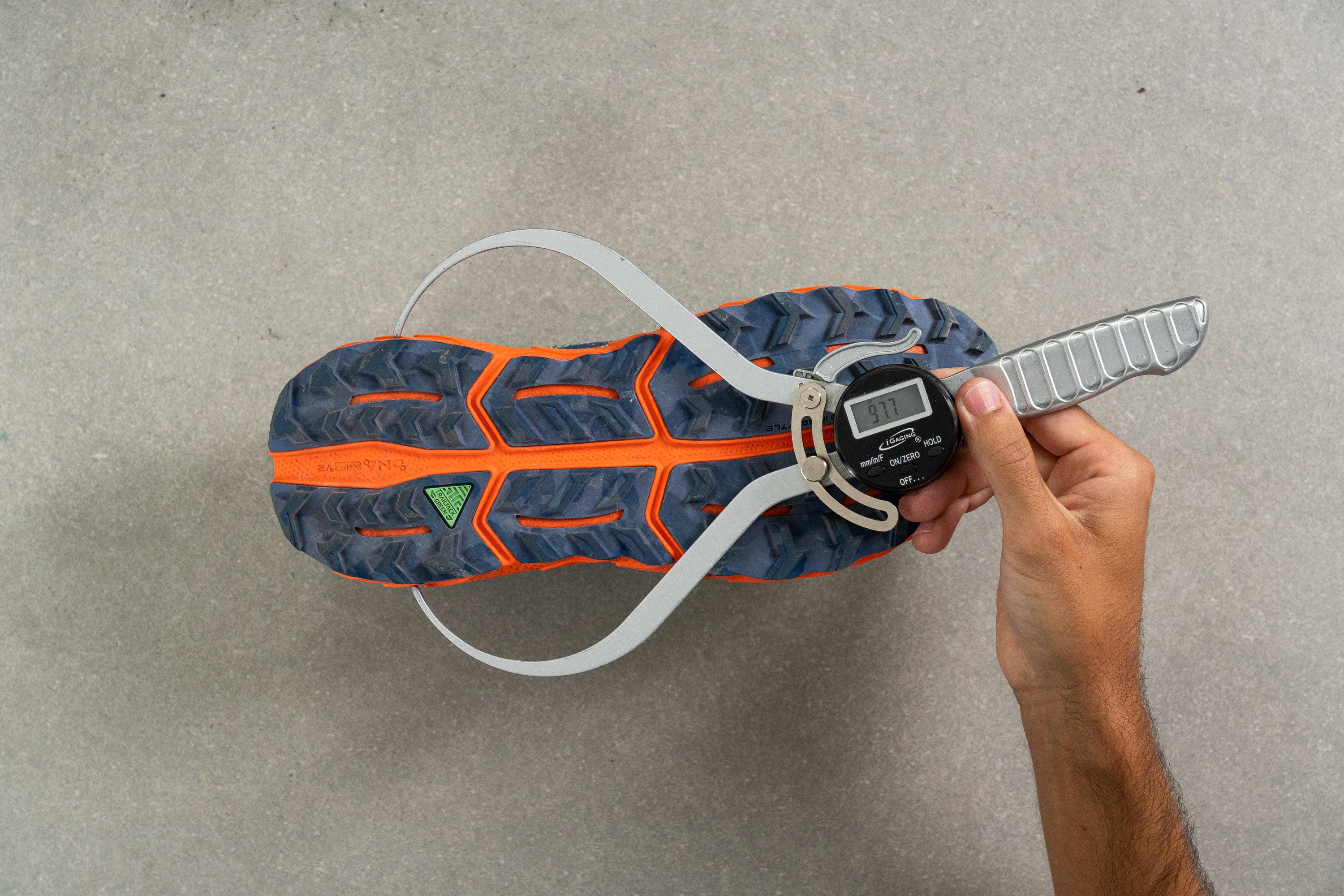
| Cascadia 17 | 97.7 mm |
| Average | 89.9 mm |
Durability
Toebox durability
Often, impressive breathability comes at the cost of durability, and that seems to be the situation with the Cascadia.
When we tested the upper with the Dremel, it didn't hold up for long and we gave it a 2/5. However, there is a protective layer in the most vulnerable parts of the toe box. So, we believe the likelihood of them tearing prematurely is minimal.

| Cascadia 17 | 2 |
| Average | 3.1 |
Heel padding durability
The heel also disappoints with a low 1-out-of-5 rating.
If you're a runner who experience wear in the Achilles area of trail shoes, you might face problems with this model sooner than you'd like. It performed notably worse than the Salomon Ultra Glide in the right.

| Cascadia 17 | 1 |
| Average | 3 |
Outsole hardness
We recorded the hardness of Brooks' TrailTack Green rubber at 81.8 HC.
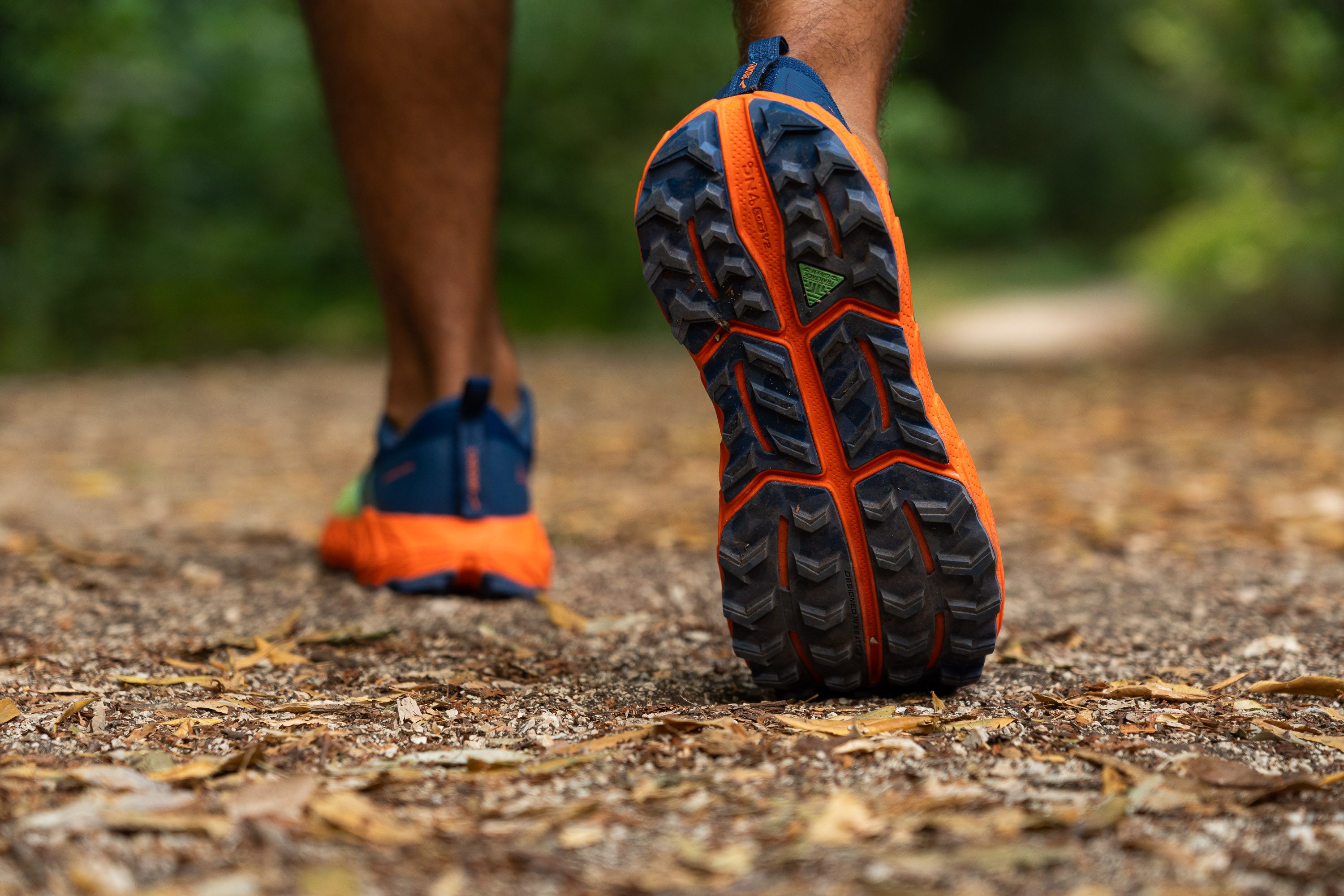
This reveals the brand's focus on enhancing the shoe's grip. However, could this affect its long-term durability?
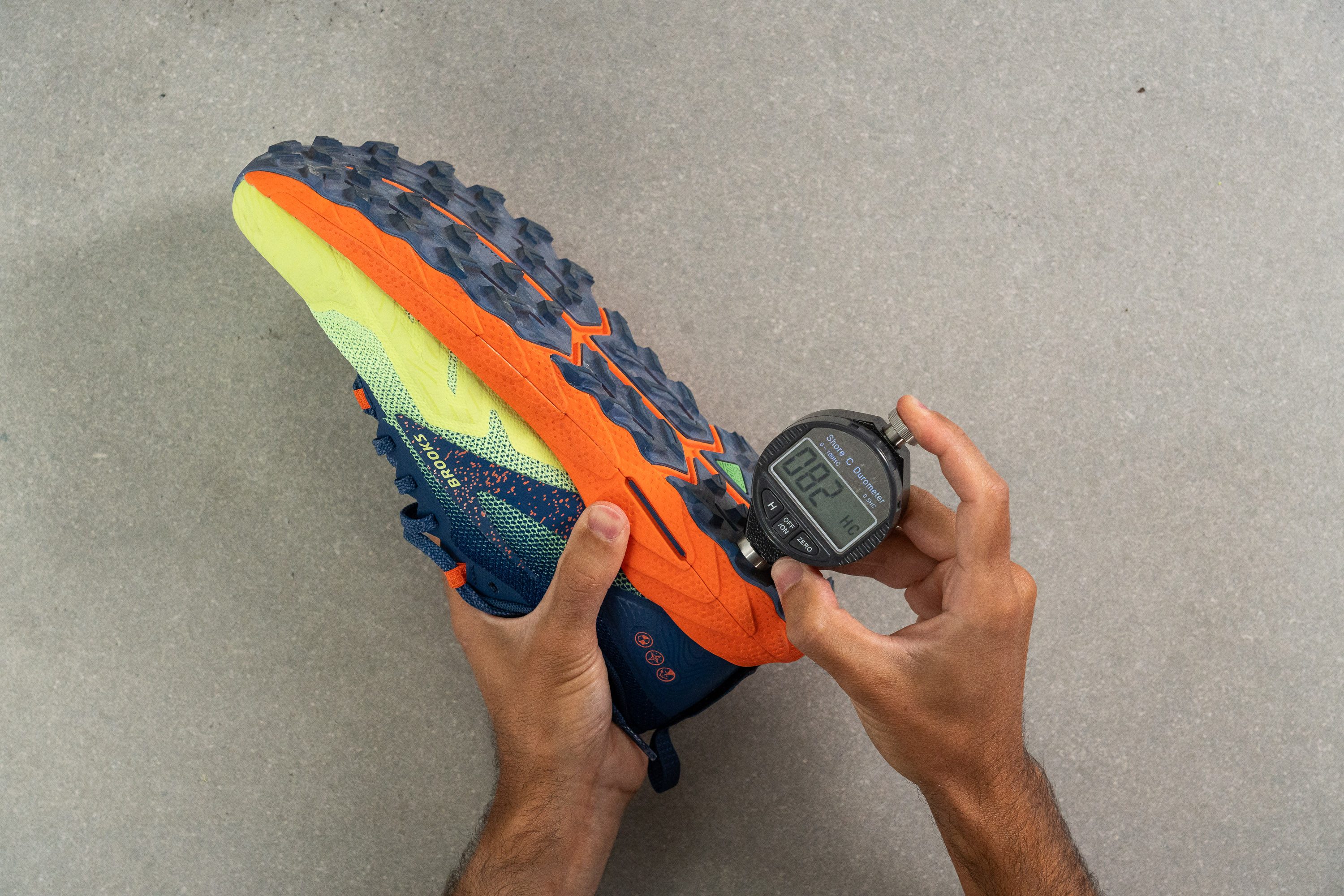
| Cascadia 17 | 81.8 HC |
| Average | 85.8 HC |
Outsole durability
Although it's not the toughest rubber we've seen, it held up impressively in our Dremel test.
We managed to make only a slight indentation of 0.8 mm.
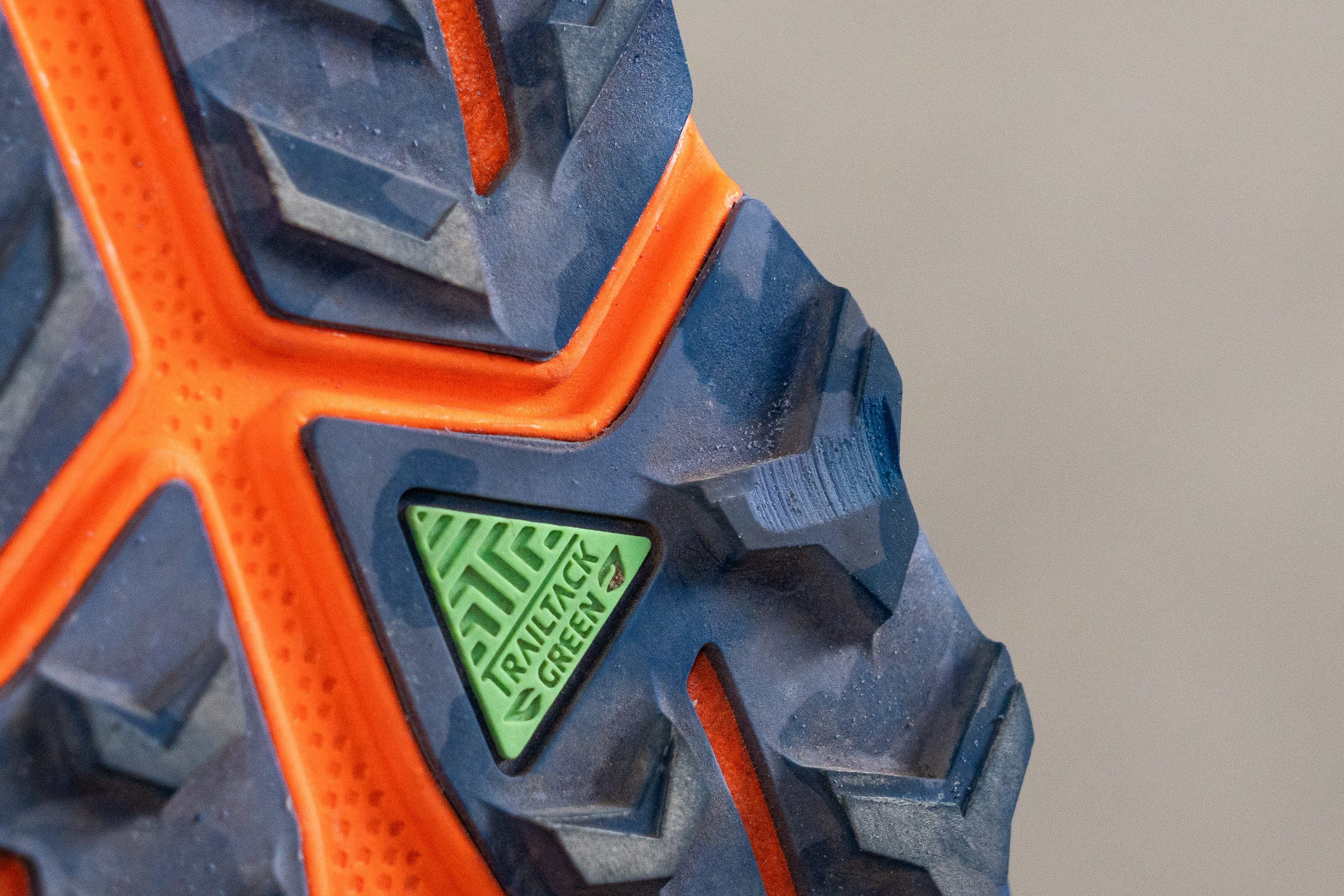
| Cascadia 17 | 0.8 mm |
| Average | 0.9 mm |
Outsole thickness
The outsole boasts a generous amount of rubber that seems built to last. We'll discuss the lugs shortly, but for the base layer alone, we found it to be 2.0 mm thick. With the addition of the lugs, that's plenty durable!
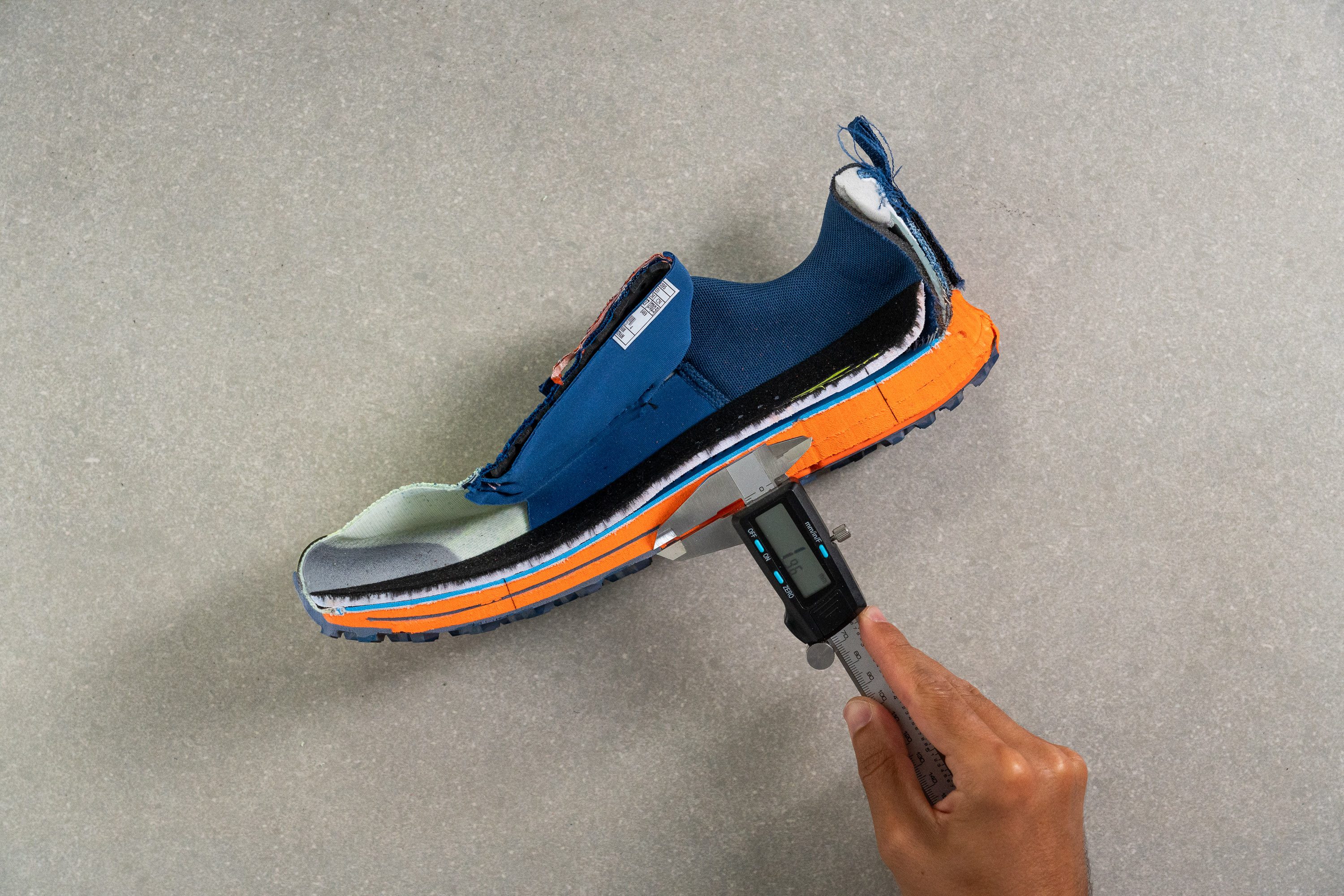
| Cascadia 17 | 2.0 mm |
| Average | 2.2 mm |
Misc
Insole thickness
There's not much to highlight about the insole—it does its job well and feels comfortable. Our measurements show it at 4.8 mm, which is right around the average.

| Cascadia 17 | 4.8 mm |
| Average | 4.7 mm |
Removable insole
The insole in this shoe is conveniently removable, allowing you to effortlessly fit your own custom third-party orthotics.

| Cascadia 17 | Yes |
Midsole softness in cold (%)
Running shoe foams can be temperature-sensitive—especially when it comes to EVA-based ones like the DNA Loft v2 foam from Brooks. Hence this foam is likely to firm up in colder weather.
To test this, we placed the shoe in our freezer for 20 minutes and then measured its hardness. Sure enough, we found a reading of 33.8 HA, confirming that it does get firmer in cold conditions.
Seeing a 32.4% increase might be acceptable for an EVA-based foam, but it's disappointing for a shoe that isn't exactly super-easy on the wallet.
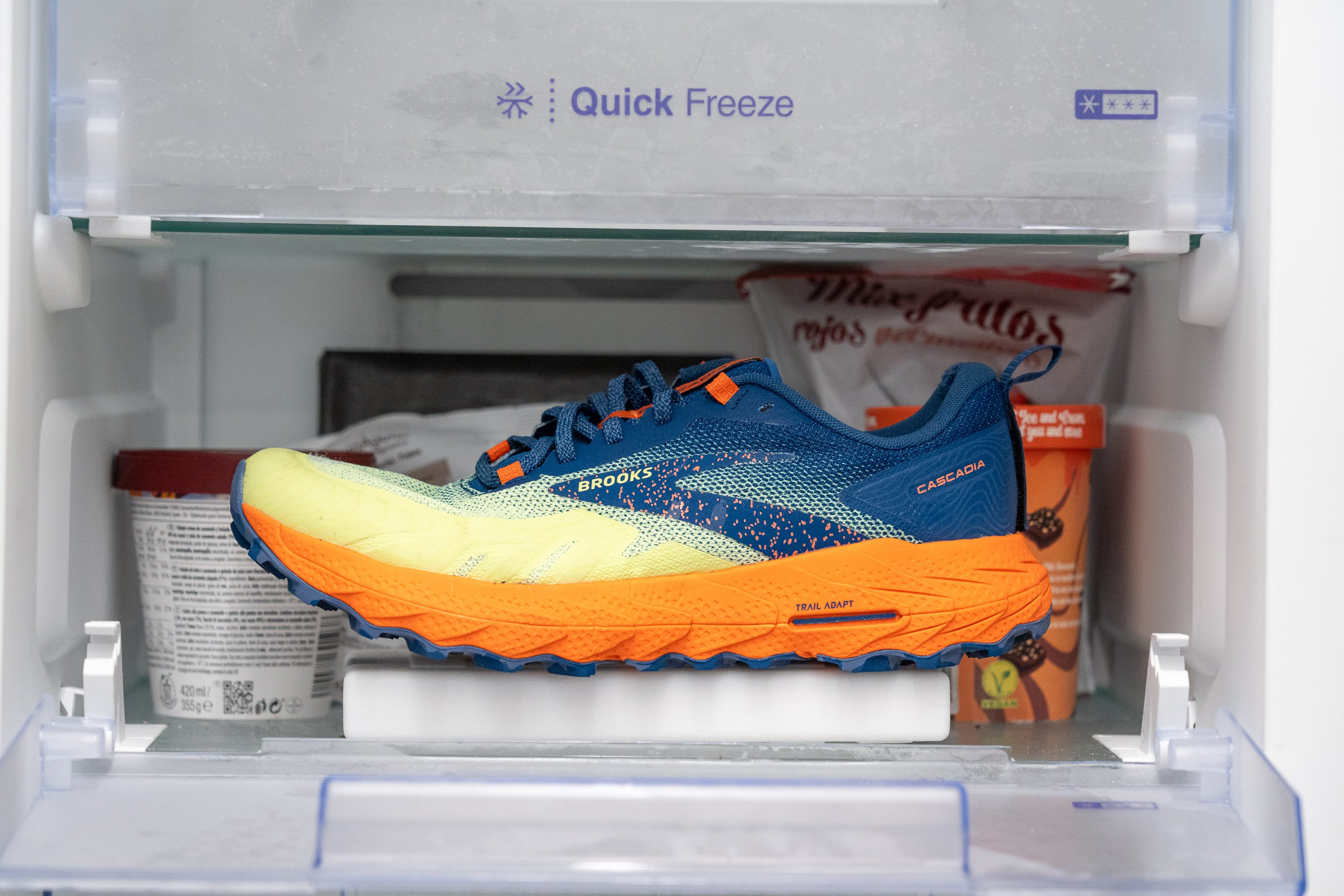
| Cascadia 17 | 32% |
| Average | 26% |
Reflective elements
While a vast majority of trail runners don't venture out into the mountains after dark, a minority relish the thrill of lighting up their path with a headlamp and hitting the trails. This group would certainly have welcomed such a feature for those night runs. Maybe we'll get it in the Cascadia 18!
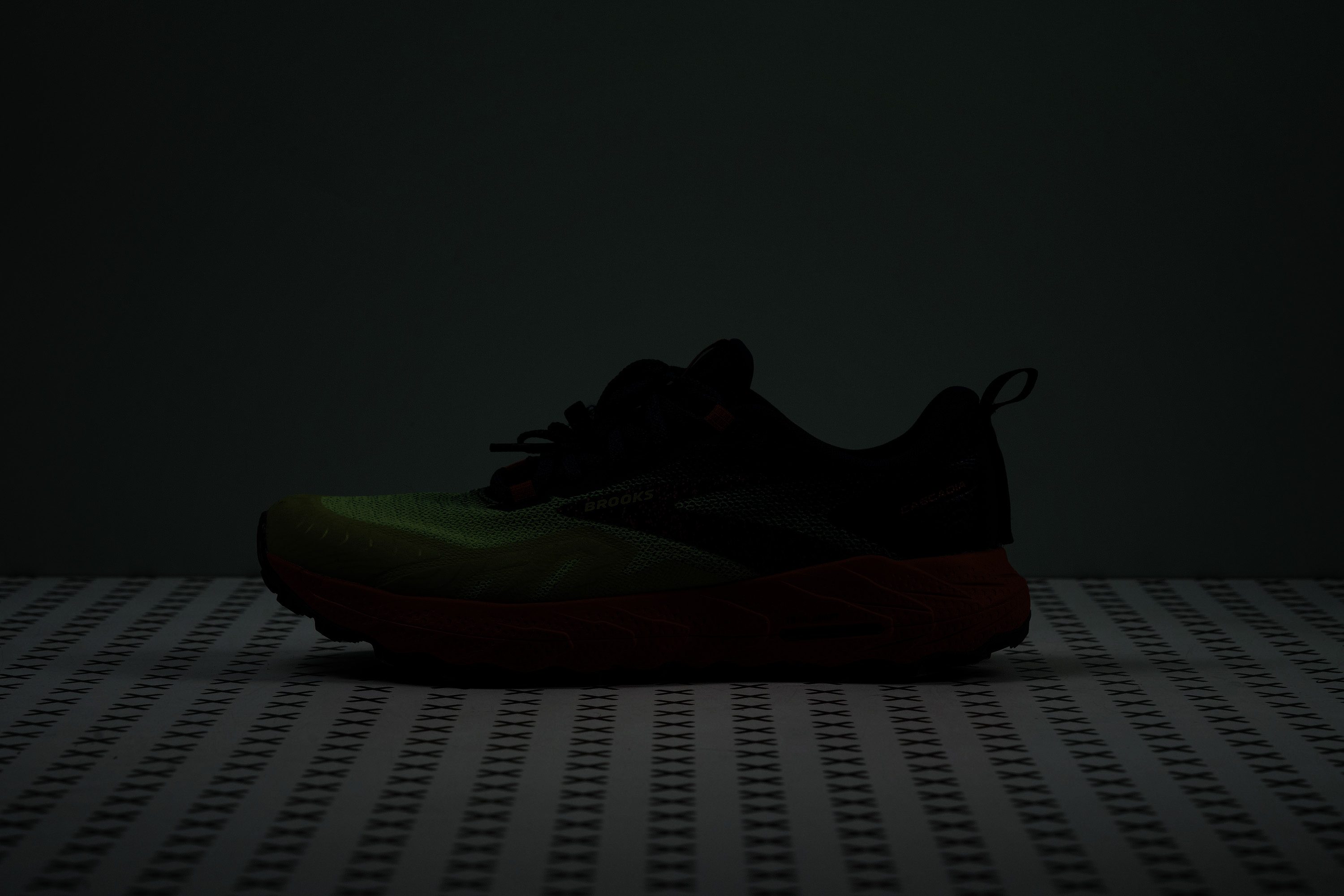
| Cascadia 17 | No |
Tongue padding
A big change from the previous Cascadia is the tongue-padding. The Cascadia 16 had a super-thick 12.2-mm tongue, while this model showcases a much-slimmer 4.7-mm design—almost a third of the thickness!
But there's no need to worry. Even though 4.7 mm might appear on the slim side for longer workouts—and we'd have liked a 6 or 7-mm thickness—this change doesn't compromise comfort too much.
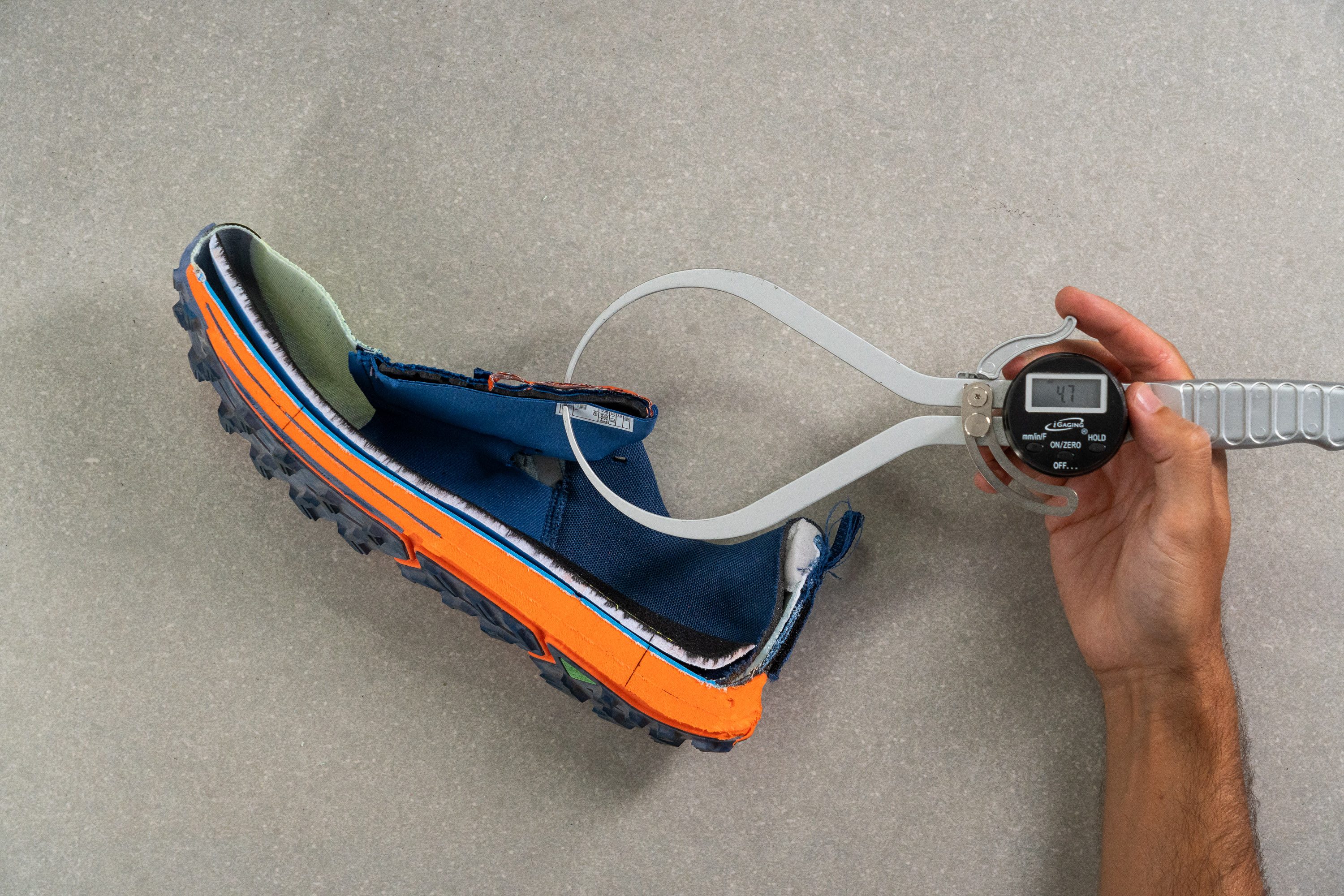
| Cascadia 17 | 4.7 mm |
| Average | 6.4 mm |
Tongue: gusset type
When it comes to the tongue, the Cascadia 17 features a semi-gusseted design that ensures a snug yet comfortable fit.
While some trail runners might lean towards a fully gusseted tongue to maximize interior sealing, we believe this tongue is more gentle on the feet, especially for long-distance runs.
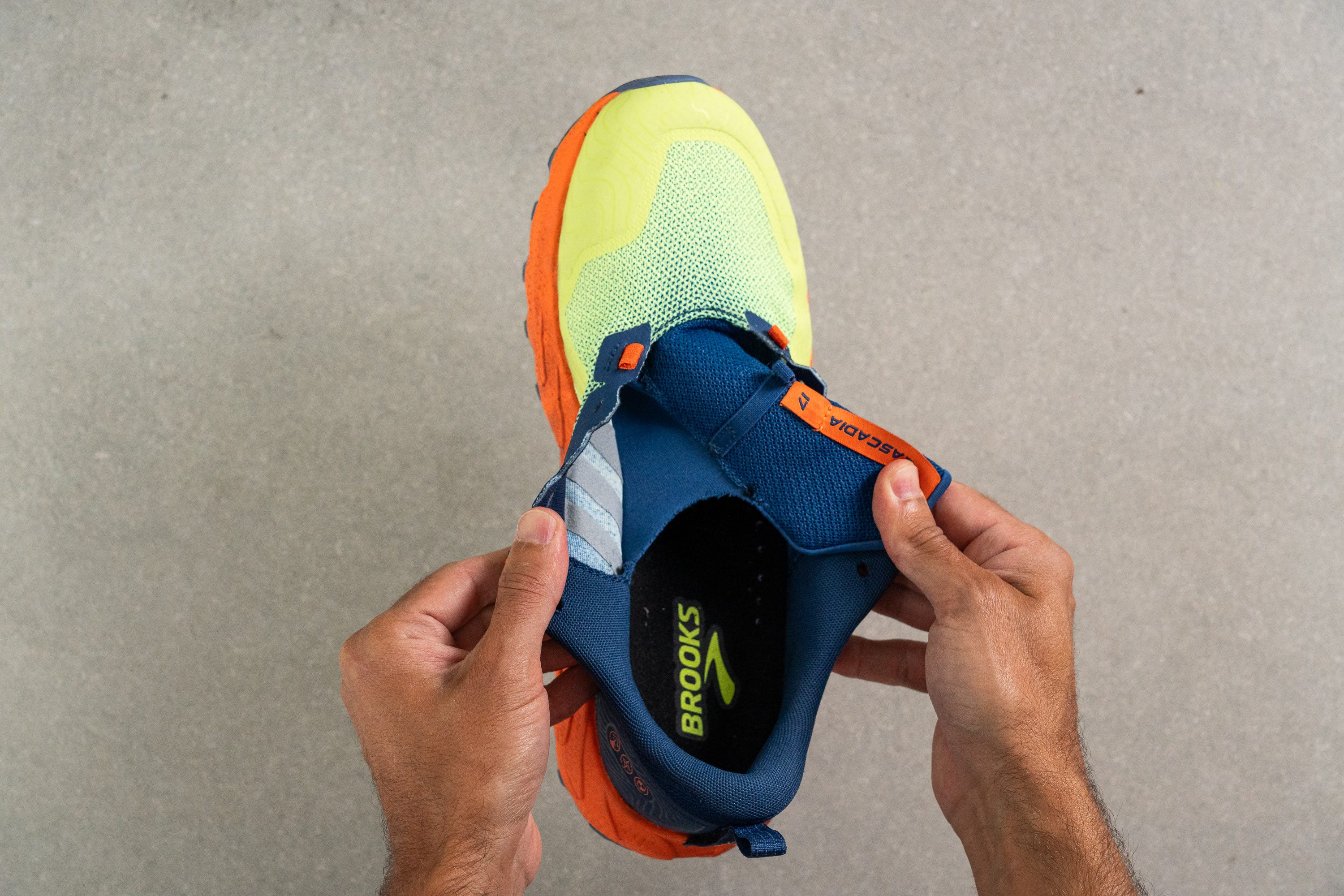
| Cascadia 17 | Both sides (semi) |
Heel tab
On the heel, we find a original and rare pull tab. Instead of the typical finger-loop design, this one attaches to the shoe with velcro, letting us adjust it to our preference.
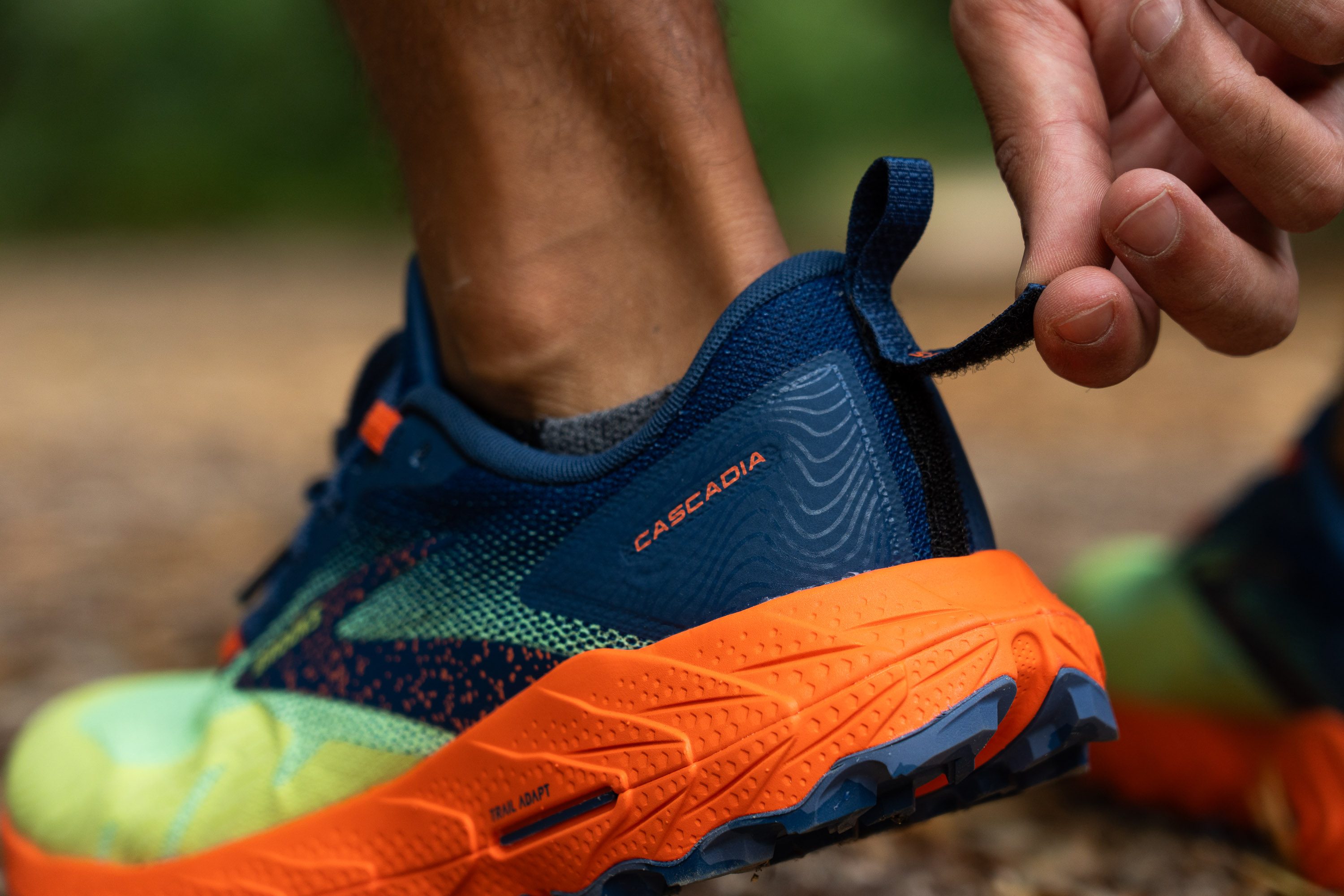
| Cascadia 17 | Pull tab |

